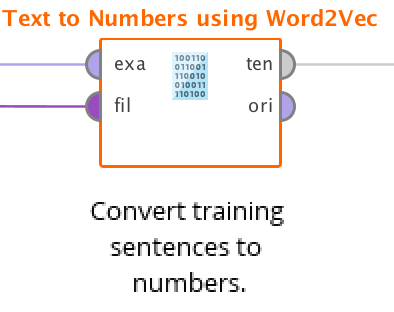A more native Deep Learning solution
 pschlunder
Employee-RapidMiner, RapidMiner Certified Analyst, RapidMiner Certified Expert, RMResearcher, Member Posts: 96
pschlunder
Employee-RapidMiner, RapidMiner Certified Analyst, RapidMiner Certified Expert, RMResearcher, Member Posts: 96 Let me introduce you our new Deep Learning extension!
At its core, this new extension focuses on bringing you a more RapidMiner-native Deep Learning experience. The initial release gets you started with ExamplesSets and explores textual data, running on CPU or GPU as you like.

With this new extension the entry hurdle of creating your first Deep Learning model is lower than before; there is no need of installing anything but the extension (download it here)! There is no need to set up input shapes! And there is no need for an extra operator to apply your model on ExampleSets! There are more VISUALS, more GUIDANCE, and more SPEED due to a java-based execution!
 More visual layer architecture, thanks to explanatory and individual icons per layer.
More visual layer architecture, thanks to explanatory and individual icons per layer.
Sample processes include guidance on different architectures, how to handle various data types, how to optimize networks, and learning how to use this operator:
The new Deep Learning extension provides an updateable model. This feature allows to continue training further on. So if the training took a while and new data is present, just continue training with it instead of having to start all over again. A growing number of tutorial processes, including tips and tricks.
A growing number of tutorial processes, including tips and tricks.
To speed up things with big data sets, execution on GPU is also available. You'll find the switch in the general settings:

Deep Learning techniques require numerical data, so conversion methods for text are needed. A first operator for text-to-numerical conversion is now included: The extension is powered by the open-source library DeepLearning4J (version 1.0.0-beta). Check out their website and github.
The extension is powered by the open-source library DeepLearning4J (version 1.0.0-beta). Check out their website and github.
We're just getting started with this native integration, so stay tuned for more features and types of data being easily usable for Deep Learning in RapidMiner!
Philipp


Comments
Hallo Philip,
In your webinar "An Introduction to Deep Learning with RapidMiner", you mention Keras, Tensorflow, MS CNTK, Theano; is it necessary to install these softwares to perform Deep Learning with RapidMiner? Given that RM offers the operator "Deep Learning", what are the advantages of Keras, Tensorflow, MS CNTK, Theano? Is there any XML example of Deep Learning available? Does MS CNTK work as standalone or as extension of RapidMiner?
Thanks,
Maerkli.
@pschlunder It would be great to have the Deep Learning Extension with GPU support and the legacy versions of NVIDIA CUDA SDK (in a way similar to MXNET, which provides mutiple installers depending on your emvironment). As the majority (pure stats rather than favours) of Deep Learning community would be working with Tensorflow, it would be great to have a version of the extension that is compatible with CUDA SDK that Tensorflow currently uses as well. At the time of writing this post, Tensorflow requires CUDA 9.0, while DL4J (and thus the DL Extension) wants CUDA 9.1, while the most up to date version of CUDA is 10.0 anyway. So if you work with RapidMiner and its Keras extension, which relies on Tensorflow (as one of the backends) and CUDA 9.0, you cannot use Deep Learning Extension, which uses DL4J and CUDA 9.1.
Jacob
Hi @Maerkli,
the webinar you mentioned shows the usage of the Keras extension. It has several requirements with regards to software that you need to install first. See this post here.
The deep learning operator readily available in RapidMiner Studio uses H2Os neural network and allows you to create networks with fully-connected layers. The Keras extension or the new Deep Learning extension on the other hand allow you to also use other types of layers.
When you're just getting started I'd use the preinstalled Deep Learning operator (the H2O) to make yourself familar with it. Later on I'd install the new Deep Learning extension as described in this knowledge base article here.
Currently the Keras extension still has some more layers, that the new Deep Learning extension doesn't offer, yet. But it might be more tricky to use it.
Regarding learning/example processes:
Both the Keras and the Deep Learning extension come with sample processes included. Check your repository after installing given extension. The Keras extension adds a folder "Keras samples", while the new Deep Learning extension adds a folder "Deep Learning" to the native "Samples" repository.
The included Deep Learning operator (the H2O one) also has some tutorial processes. Just click on the operator, check the help view and select one of the linked tutorial processes there.
Hope this helps.
Philipp
Hi @jacobcybulski,
that's a very good remark. Currently one problem is, that the dependencies for supporting different CUDA versions are quite big (in comparison to the overall extension size). Hence we're only shipping one. Also we're working on a solution, we might just go with supporting 9.0 for the next release. Hence 9.1 and higher should be compatible, while you'd still be able to just use 9.0 for our extension as well as Tensorflow and the like.
Regards,
Philipp
Merci Philipp.
Maerkli.